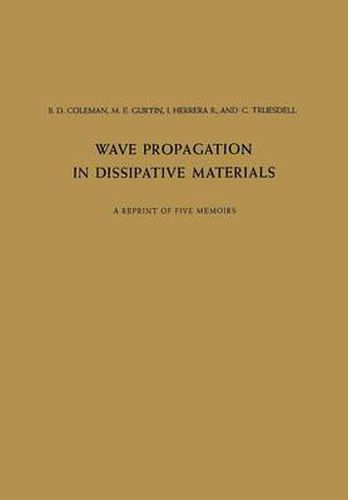Wave Propagation in Dissipative Materials: A Reprint of Five Memoirs
B.D. Coleman,M.H. Gurtin,R.I. Herrera,C. Truesdell

Wave Propagation in Dissipative Materials: A Reprint of Five Memoirs
B.D. Coleman,M.H. Gurtin,R.I. Herrera,C. Truesdell
This title is printed to order. This book may have been self-published. If so, we cannot guarantee the quality of the content. In the main most books will have gone through the editing process however some may not. We therefore suggest that you be aware of this before ordering this book. If in doubt check either the author or publisher’s details as we are unable to accept any returns unless they are faulty. Please contact us if you have any questions.
Common experience reveals two basic aspects of wave propagation. First, while preserving their identity and travelling at definite speeds, sounds finally die out. Second, weak sounds may combine to form strong noises. Theories of acoustic propagation have succeeded in representing these aspects of experience separately, but never combined as in nature. The classical theories of sound in perfect fluids and elastic solids easily yield common speeds of propagation for plane infinitesimal disturbances, but no damping. Moreover, within EULER’S theory of the perfect fluid, or its generalization, the GREEN-KIRCHHOFF-KELVIN theory of finite elasticity, weak waves may grow stronger and become shock waves, which propagate according to more complicated but equally definite principles. Effects of internal damping are easily added for theories of infinitesimal deformation, but for finite motions a dead end was reached about sixty years ago. Indeed, in 1901 DUHEM proved that according to the NAVIER-STOKES theory of fluids acceleration waves and waves of higher order cannot exist, and for shock waves he claimed a similar result, which has since been shown to be valid subject to certain qualifications. So as to save the phenomena of sound and noise, as was necessary if the NAVIER-STOKES theory was to deserve the place proposed for it as a refinement upon EULER’S theory, DUHEM introduced the concept of quasi-wave , a region of rapid but continuous transition.
This item is not currently in-stock. It can be ordered online and is expected to ship in 7-14 days
Our stock data is updated periodically, and availability may change throughout the day for in-demand items. Please call the relevant shop for the most current stock information. Prices are subject to change without notice.
Sign in or become a Readings Member to add this title to a wishlist.


